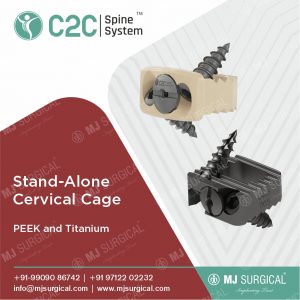The most common surgical therapy for various cervical spinal illnesses, including herniated discs, compressive myelopathy, trauma, and degenerative disease, is anterior cervical discectomy and fusion (ACDF). This surgery is utilized to decompress the spinal cord and nerve root while also stabilizing the damaged parts. For these reasons, various technical changes to this surgery, such as stand-alone cages, anterior cervical plates, zero-profile devices, and so on, have been created. However, there is presently no agreement on the best approach. The purpose of this surgery is to enhance the patient’s symptoms, spine stability, and lordships. Here are some of the basic information about the Stand Alone Cage in the spine degenerative disease.
How Do They Choose The Patients
The patients with degenerative cervical disease had been diagnosed and treated on this. Patients who underwent single-level ACDF surgery were chosen. Before and after surgery, patients used a visual analog scale to rate their level of discomfort. Subsidence was defined as a 3-mm reduction in segmental height, and cervical kyphosis was defined as a 5-degree advancement at 12 months following surgical follow-up compared to that evaluated immediately after surgery.
Clinical Evaluation Before The Stand Alone Cage Surgery
Pre- and postoperative Natick and Visual Analog Scale for neck and radicular pain, as well as the Neck Disability Index and Japanese Orthopedic Association score for myelopathy, were used to evaluate clinical preoperative evaluation and surgical results. Data were obtained prospectively during the preoperative examination, as well as immediately after surgery, 3 months, 6 months, and 12 months thereafter.
What Is The Surgical Procedure
ACDF was done from the right side while the patient was supine and under general anesthesia. Soft tissues were dissected using a transverse skin incision. The disc was then identified using fluoroscopic guidance, and the discectomy was performed. Lower anterior lip from upper vertebral body and osteophytes from lower and upper vertebral bodies were carefully removed and collected using a Kerri son punch.

Both the top and lower endplates were meticulously prepared without the use of a drill. In the disc space, a PEEK cage of sufficient size was implanted, which was filled with those local autologous bone pieces. Following surgery, all patients were treated with the same routine of rest and a soft cervical collar for 6 weeks, followed by gentle physiotherapy.
Radiology Evaluation
- Plain Posterior Cervical Screw and lateral radiographs were taken before, during, and after surgery, as well as 12 months afterward. Before surgery, MRI scans were also collected. To compare the stand-alone cage group and the plate-assisted cervical fusion group, construct length and spinal curvature were assessed.
- On plain radiographs, the construct length was measured as the distance between the anterior and posterior sides of the superior endplate of the top level of the fusion and the midpoint of the inferior endplate of the bottom level of the fusion. Subsidence was defined as a 3mm or greater decrease in segmental height at the 1-year postoperative follow-up compared to the immediate postoperative period.
- Cobb angle was used to calculate cervical spinal curvature. The Cobb ratio is defined as the angle created by a demarcation line parallel to the superior abutment of a spine one level just above the bulging disc and a dividing line parallel to the inadequate endplate of a vertebra one level below the bulging disc.
What About The Pain After The Surgery
Before and after surgery, patients’ pain levels were assessed using a visual analog scale for neck and radicular pain. Preoperative pain was assessed during the admission process. And frequent follow-ups were performed 3 months, 6 months, and 12 months after surgery.
Key Takeaways
This is how the Stand Alone Cage has been used for spine degenerative diseases. More than medical advice, it is very important to use the right instrument. So, ask your doctor to book your cage at MJ Surgical. We assure you to deliver a high-quality and super sterilized cage for your surgery in the size and material you want. For exploring more, give a visit to the website.